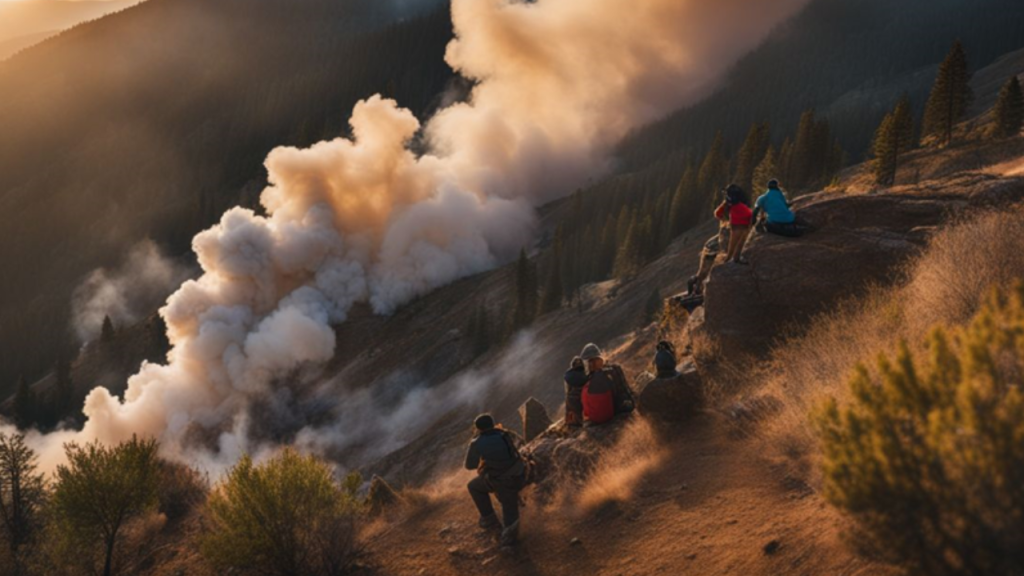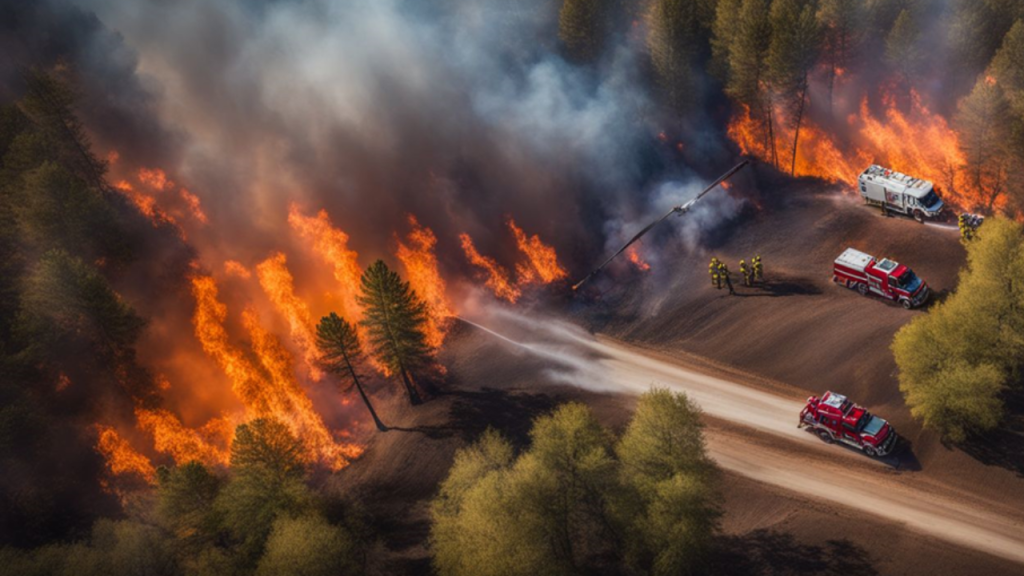
Wildfires have become a devastating annual event in California, challenging the state’s capacity for effective fire management. One innovative solution is AI technology; Cal Fire, the Californian firefighting agency, now utilizes AI models and cameras to proactively detect signs of wildfire.
This article will demystify how this technology aids in detecting and combating wildfires more accurately and swiftly – potentially saving countless lives and acres of forest. Let’s dive into how artificial intelligence is transforming wildfire control!
Key Takeaways
- AI technology helps Cal Fire to spot wildfires quickly.
- High-definition cameras, drones, and satellites support the system by providing valuable data.
- Over 1,000 cameras scan for smoke across vast fire-prone areas in California.
- The AI system flagged 77 fires before emergency calls were made, improving response times.
- Despite its success, the tech still needs human help to check accuracy and deal with false alerts.
- Climate change increases wildfire risks – hotter temperatures make more dry conditions that can fuel big blazes.
Understanding California Wildfires

Wildfires in California have often resulted in devastating destruction and loss. Rapid detection presents a significant challenge due to the state’s expansive fire-prone areas. The geography varies from dense forests to mountainous terrain, making human monitoring difficult and limiting the effectiveness of traditional fire detection methods like 911 calls or aircraft scouting.
The advanced technology used by Cal Fire involves AI-powered wildfire detection systems that scan footage from high-definition mountaintop cameras spread across these fire-prone zones.
This system seeks out visible signs of smoke, considering factors such as fog, dust, and haze and utilizing its machine-learning capability for anomaly detection. This effort significantly improves response times by helping firefighters identify emerging threats before fires spiral out of control.
However, it must be noted that while this innovative technology has been beneficial, it does come with limitations – its dependency on visibility means only visible fires can be detected through this system, which may require human confirmation.
The Role of AI in Wildfire Detection
AI technology is revolutionizing wildfire detection, with systems capable of scanning vast terrains for fires more accurately and quicker than traditional methods, thus speeding up response times significantly.
These AI models rely on a network of high-definition cameras equipped with smoke-detection features to spot potential fire incidents in the early stages. By using these cutting-edge tools, we can reduce human monitoring needs, leaving fewer chances for error or delay in detecting wildfires.
AI-powered wildfire detection systems
AI-powered wildfire detection systems utilize advanced technology to rapidly control and combat California wildfires. Cal Fire has integrated AI models with high-definition cameras, creating a formidable network to identify smoke signatures.
This extensive system scans over 1,000 mountaintop cameras in fire-prone areas, swiftly alerting firefighters to potential incidents even before 911 calls are received. With an impressive success rate of approximately forty percent, the AI system has picked up on seventy-seven wildfires before any human reporting.
Despite these ground-breaking achievements, people still play a crucial role in confirming alerts from the AI-powered setup due to its limitations and false positives caused by fog or dust.
This technological mashup between machines and man marks a significant stride forward in reducing response times, making firefighting efforts more manageable and efficient.
Scanning capabilities and success rates
The artificial intelligence system that detects wildfires wields a sturdy network encompassing over 1,000 high-definition mountaintop cameras. These digital eyes vigilantly overlook California’s most fire-prone territories and offer impressive scanning capabilities.
The AI program processes billions of megapixels from these cameras each minute, effectively covering about 90 percent of California’s wildfire-risk areas. Despite its state-of-the-art technology, the system still relies on human intervention to confirm alerts and gauge fire behavior due to limitations such as distinguishing smoke from fog or other atmospheric anomalies.
As an example of its efficiency, this advanced anomaly detection mechanism has achieved notable success, with a rate reaching up to 40 percent in identifying visible fires before emergency calls surface at the local 911 dispatch centers.
This significant increase in early identification significantly improves response times and aids firefighters’ efforts by pinpointing accurate locations promptly after fires ignite.
Benefits of Using AI for Wildfire Control
Artificial Intelligence offers numerous benefits in wildfire control, providing quicker detection times for faster firefighting response. Adopting AI drastically improves fire detection accuracy, significantly reducing false positives from sources like fog, haze, or steam.
Additionally, the data collected by AI systems can be harnessed to create well-informed firefighting strategies, pinpoint potential fire-prone areas, and predict future occurrences with superior precision.
This type of technology also simplifies fire monitoring in remote rural areas and can drastically decrease the time a 911 dispatch center takes to respond to emerging fires.
Ultimately, utilizing an AI approach escalates our ability to counteract devastating wildfires effectively and efficiently.
Faster detection times
AI technology dramatically shortens wildfire detection times. With a network of high-definition mountaintop cameras, the system quickly scans for signs of smoke across vast territories.
This rapid response tech detected 77 wildfires before dispatch centers received emergency 911 calls! Notably enhancing prompt action by firefighters, AI reduces fire size at suppression and overall response times.
Soon, every Cal Fire command center will have this game-changing resource for more efficient firefighting efforts in California’s most fire-prone areas.
Improved accuracy
Artificial Intelligence offers significant precision improvements in wildfire detection. AI-powered wildfire detection systems meticulously scan billions of megapixels of images every minute, covering about 90 percent of fire-prone areas in California.
This technology, finer than human eyesight, successfully distinguishes smoke from fog, haze, dust, and steam with a remarkable success rate.
The works at Mountaintop cameras around California have amplified accuracy over traditional methods. The system picked up on 77 wildfires before any 911 calls were even made, achieving a success rate of 40 percent.
These facts underscore the astounding efficiency and improved accuracy that AI brings to the field.
Data-driven firefighting strategies
Technology leaps forward with data-driven firefighting strategies in California. Artificial Intelligence (AI) powers the sophisticated system by Cal Fire to rapidly detect wildfires.
The AI scans a network of over 1,000 high-definition cameras around the clock for signs of flame or smoke. Successful instances have allowed firefighters to respond before these disasters blow out of proportion; on average, this strategy detects a wildfire 40% faster than traditional methods like 911 calls! This breakthrough is swift and expansive: it deals with billions of megapixels and covers nearly all fire-prone areas within California’s borders.
A testament to efficiency, it manages to scan vast terrains every minute yet swiftly alerts command centers about any detected anomalies.
The Future of Firefighting: AI and Analytics
Harnessing the power of AI and analytics, the future presents exciting possibilities for predictive modeling that significantly bolsters firefighting efforts, drones providing real-time fire intelligence, and satellites aiding in rapid detection, all while considering the inevitable impact brought on by climate change.
Read more to discover how this revolutionizing technology could potentially reshape battling California wildfires!
Predictive modeling
Predictive modeling plays a crucial role in AI-powered wildfire detection systems.
- Cal Fire harnesses the power of predictive modeling with AI to forecast wildfires.
- High-definition cameras fitted onto mountaintop locations capture images continuously for this purpose.
- Machine learning algorithms analyze these images, spotting possible fire signs like smoke or unusual heat signals.
- Through this process, the AI system can detect visual indicators of wildfires before human observation.
- In many instances, predictive modeling has enabled early identification of fires.
- The system identified 77 wildfires before receiving any 911 calls, showcasing its efficiency and speed.
- Real-time alerts from the AI system allow command centers to improve response times.
- Despite technological advancements, human intervention remains crucial in this field for now. Engineers from DigitalPath review each potential fire spotted by the AI to verify its accuracy.
- Operators remain mindful of false positives caused by factors like agricultural fires and fog, which the system may misinterpret.
- These ongoing refinements help improve AI models and tighten their prediction capabilities.
Drones and satellites in fire control
Unmanned aerial vehicles, drones, and satellites play a pivotal role in wildfire control in California.
- Drones perform regular flight missions over fire-prone areas to conduct real-time inspections for any signs of smoke or fire.
- Equipped with high-definition cameras and advanced heat sensors, drones can detect the slightest hint of a wildfire before it can spread.
- In addition to predicting fire occurrences, drones provide fire crews with real-time data about active fires’ strength, speed, and direction.
- Satellites monitor vast territories from space and scan for unusual heat signatures that may indicate a potential wildfire.
- Per an established arrangement between Cal Fire and the United States Military Partnership, satellite data on wildfires is shared every 15 minutes.
- The real-time insights this vigilant surveillance generates enable early detection of wildfires and rapid mobilization of firefighting resources.
- Using radar technology, experts like meteorologist Craig Clements analyze data from these flights to study fire structures and forecast their potential behavior.
The impact of climate change
Climate change significantly influences the intensity and frequency of wildfires. Rising temperatures, exacerbated by global warming, contribute to longer fire seasons and drier conditions – an ideal setting for wildfires.
California seems particularly prone to these effects of climate change with its changing landscapes due to more frequent droughts and higher-than-average temperatures.
The creation of vast burn scars from escalating wildfire incidents is another distressing impact of climate change. Beyond damage control, these scarred areas pose a daunting challenge to restoring water quality and soil health.
Disturbingly, eroded landscapes can give way easily during heavy rains, fostering mudslides afflicting locations already severely hit by huge fires, thus exacerbating ecological disturbances even further in this fire-prone territory.
Challenges and Limitations of AI in Wildfire Control
Artificial Intelligence is by no means infallible when it comes to identifying and controlling wildfires. Even with its advanced software, the system currently used by Cal Fire only successfully detects fires before receiving 911 calls about 40 percent of the time.
Further complicating matters are false positives—alerts triggered by factors other than fires, such as fog, dust, and steam—which can interrupt important workflows and divert precious resources.
Additionally, skepticism still thrives among experienced fire operators regarding the AI’s ability to distinguish between different types of fires, like agricultural ones, which could be approved for controlled burns versus uncontrolled wild infernos.
Despite abundant high-resolution images processed every minute covering most at-risk areas in California, human intervention remains necessary for validating AI-triggered alerts.
Thus, while it proves helpful in many instances for early detection and rapid response strategies, there remains a need to address these significant limitations inherent in the current AI systems instrumental in wildfire control efforts.
Conclusion
The revolutionary usage of AI technology is dramatically changing the face of wildfire detection and management in California. Implementing artificial intelligence enhances swift wildfire identification, improving both response times and firefighting strategies.
High-definition cameras coupled with human supervision ensure accurate detection while limiting misinterpretations. This high-tech synergy paints an encouraging future for fire-prone territories, symbolizing a giant leap forward in our enduring battle against devastating wildfires.



